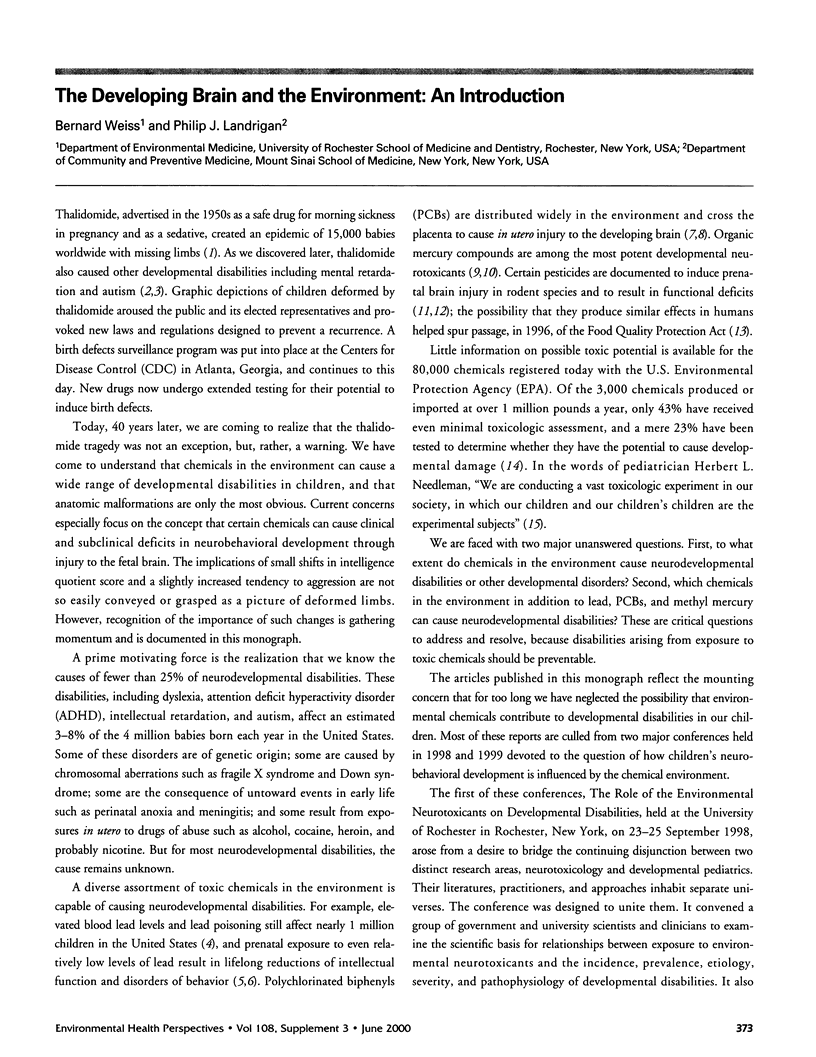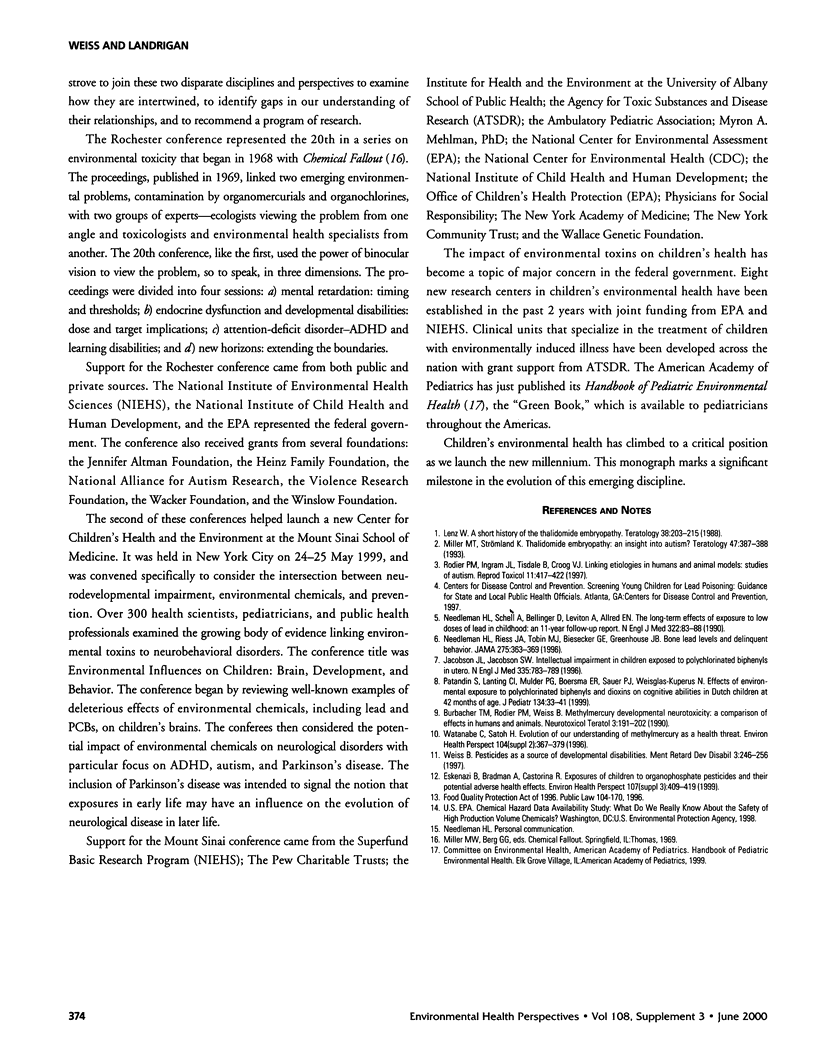Abstract
mental retardation: timing and thresholds; (italic)b(/italic)) endocrine dysfunction and developmental disabilities: dose and target implications; (italic)c(/italic)) attention-deficit disorder-ADHD and learning disabilities; and (italic)d(/italic)) new horizons: extending the boundaries. Support for the Rochester conference came from both public and private sources. The National Institute of Environmental Health Sciences (NIEHS), the National Institute of Child Health and Human Development, and the EPA represented the federal government. The conference also received grants from several foundations: the Jennifer Altman Foundation, the Heinz Family Foundation, the National Alliance for Autism Research, the Violence Research Foundation, the Wacker Foundation, and the Winslow Foundation. The second of these conferences helped launch a new Center for Children's Health and the Environment at the Mount Sinai School of Medicine. It was held in New York City on 24-25 May 1999, and was convened specifically to consider the intersection between neurodevelopmental impairment, environmental chemicals, and prevention. Over 300 health scientists, pediatricians, and public health professionals examined the growing body of evidence linking environmental toxins to neurobehavioral disorders. The conference title was Environmental Influences on Children: Brain, Development, and Behavior. The conference began by reviewing well-known examples of deleterious effects of environmental chemicals, including lead and PCBs, on children's brains. The conferees then considered the potential impact of environmental chemicals on neurological disorders with particular focus on ADHD, autism, and Parkinson's disease. The inclusion of Parkinson's disease was intended to signal the notion that exposures in early life may have an influence on the evolution of neurological disease in later life. Support for the Mount Sinai conference came from the Superfund Basic Research Program (NIEHS); The Pew Charitable Trusts; the Institute for Health and the Environment at the University of Albany School of Public Health; the Agency for Toxic Substances and Disease Research (ATSDR); the Ambulatory Pediatric Association; Myron A. Mehlman, PhD; the National Center for Environmental Assessment (EPA); the National Center for Environmental Health (CDC); the National Institute of Child Health and Human Development; the Office of Children's Health Protection (EPA); Physicians for Social Responsibility; The New York Academy of Medicine; The New York Community Trust; and the Wallace Genetic Foundation. The impact of environmental toxins on children's health has become a topic of major concern in the federal government. Eight new research centers in children's environmental health have been established in the past 2 years with joint funding from EPA and NIEHS. Clinical units that specialize in the treatment of children with environmentally induced illness have been developed across the nation with grant support from ATSDR. The American Academy of Pediatrics has just published its (italic)Handbook of Pediatric Environmental Health (/italic)((italic)17(/italic)), the "Green Book," which is available to pediatricians throughout the Americas. Children's environmental health has climbed to a critical position as we launch the new millennium. This monograph marks a significant milestone in the evolution of this emerging discipline.
Full text
PDF

Selected References
These references are in PubMed. This may not be the complete list of references from this article.
- Burbacher T. M., Rodier P. M., Weiss B. Methylmercury developmental neurotoxicity: a comparison of effects in humans and animals. Neurotoxicol Teratol. 1990 May-Jun;12(3):191–202. doi: 10.1016/0892-0362(90)90091-p. [DOI] [PubMed] [Google Scholar]
- Eskenazi B., Bradman A., Castorina R. Exposures of children to organophosphate pesticides and their potential adverse health effects. Environ Health Perspect. 1999 Jun;107 (Suppl 3):409–419. doi: 10.1289/ehp.99107s3409. [DOI] [PMC free article] [PubMed] [Google Scholar]
- Jacobson J. L., Jacobson S. W. Intellectual impairment in children exposed to polychlorinated biphenyls in utero. N Engl J Med. 1996 Sep 12;335(11):783–789. doi: 10.1056/NEJM199609123351104. [DOI] [PubMed] [Google Scholar]
- Lenz W. A short history of thalidomide embryopathy. Teratology. 1988 Sep;38(3):203–215. doi: 10.1002/tera.1420380303. [DOI] [PubMed] [Google Scholar]
- Needleman H. L., Riess J. A., Tobin M. J., Biesecker G. E., Greenhouse J. B. Bone lead levels and delinquent behavior. JAMA. 1996 Feb 7;275(5):363–369. [PubMed] [Google Scholar]
- Needleman H. L., Schell A., Bellinger D., Leviton A., Allred E. N. The long-term effects of exposure to low doses of lead in childhood. An 11-year follow-up report. N Engl J Med. 1990 Jan 11;322(2):83–88. doi: 10.1056/NEJM199001113220203. [DOI] [PubMed] [Google Scholar]
- Patandin S., Lanting C. I., Mulder P. G., Boersma E. R., Sauer P. J., Weisglas-Kuperus N. Effects of environmental exposure to polychlorinated biphenyls and dioxins on cognitive abilities in Dutch children at 42 months of age. J Pediatr. 1999 Jan;134(1):33–41. doi: 10.1016/s0022-3476(99)70369-0. [DOI] [PubMed] [Google Scholar]
- Rodier P. M., Ingram J. L., Tisdale B., Croog V. J. Linking etiologies in humans and animal models: studies of autism. Reprod Toxicol. 1997 Mar-Jun;11(2-3):417–422. doi: 10.1016/s0890-6238(97)80001-u. [DOI] [PubMed] [Google Scholar]
- Watanabe C., Satoh H. Evolution of our understanding of methylmercury as a health threat. Environ Health Perspect. 1996 Apr;104 (Suppl 2):367–379. doi: 10.1289/ehp.96104s2367. [DOI] [PMC free article] [PubMed] [Google Scholar]


